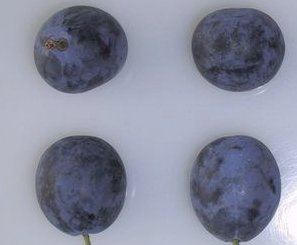PARENTAGE OF FARLEIGH DAMSON TREE
The parents are not known, this was a chance seedling found in Farleigh, Kent. It was first introduced formally in 1820.
APPEARANCE, TASTE AND CHARACTERISTICS OF FARLEIGH DAMSONS
Farleigh produces small sized damsons but the sheer volume, regularly produced, more than makes up for their size. The damsons are almost black in colour with a pronounced bloom to them. The damsons are not quite sweet enough to eat raw but they are not that far off. They make excellent pies, jams and top quality wines.
As well as large crops, Farleigh is one of the most hardy of all the damsons. When small orchards were common in the UK this variety was frequently used as a windbreak. Cold, windy, even wet conditions are shrugged off.
Farleigh Damsons
(picture courtesy National Archives)
Overall tree size is of course primarily dependant on the rootstock but also on the growing conditions. On average the following tree sizes by rootstock are for a fully grown tree after 7 years:
- St Julien A – unpruned height 4m / 13ft, pruned height 3.5m / 11ft
- VVA-1 – unpruned height 3.5m / 11ft, pruned height 2.5m / 8ft
- Pixy – unpruned 3m / 10ft. pruned height 2.5m / 8ft
Our advice, regarding rootstocks, for growing a Farleigh damson tree in almost all conditions would be the St Julien A rootstock. You’ll get a decent sized, relatively vigorous tree which won’t swamp the average garden. If your garden is on the small size and your soil is well-drained and nutrient rich it may be worth thinking about a Pixy rootstock. However, even in a smallish garden we would suggest that an appropriately pruned Farleigh damson tree on Julien A rootstock would be your best bet.
Your tree should produce a small crop three years after it has been planted and will reach its full-cropping capability five years after planting.
PRUNING FARLEIGH DAMSON TREES
The only time you will need to prune this tree is to keep it within bounds. No special techniques are required. If the tree starts to produce damsons only on higher branches, prune back more severely to bring the crop to a lower level.
PESTS, DISEASES OF FARLEIGH DAMSON TREES
Farleigh Damson is very resistant to diseases which affect plum trees in general but if your tree has problems then consult our pest and disease page. This variety is particularly resistant to Silver leaf Disease.
POLLINATION PARTNERS FOR FARLEIGH TREES
Farleigh damson trees are in pollination group 3 and is self-fertile although it would do better with a pollination partner nearby. The following varieties are good pollination partners:
- Avalon – pollination group 2, partially self-fertile
- Belle de Louvain – pollination group 3, self-fertile
- Blue Tit – pollination group 4, self-fertile
- Cambridge Gage – pollination group 3, partially self-fertile
- Coe’s Golden Drop – pollination group 2, self-sterile, needs another pollination partner
- Czar – pollination group 3, self-fertile
- Denniston’s Superb – pollination group 2, self-fertile
- Excalibur – pollination group 2, partially self-sterile
- Haganta – pollination group 3, partially self-fertile
- Herman – pollination group 2, self-fertile
- Jefferson – pollination group 2, self-sterile
- King Damson – pollination group 2, self-fertile
- Langley Bullace – pollination group 3, self-fertile
- Merryweather – pollination group 3, self-fertile
- Opal – pollination group 3, self-fertile
- Reine Claude de Bavay – pollination group 3, self-fertile
- Rivers Early Prolific – pollination group 2, partially self-fertile
- Sanctus Hubertus – pollination group 2, self-sterile, needs another pollination partner
- Shropshire Prune – pollination group 3, self-fertile
- Victoria – pollination group 3, self- fertile
- Warwickshire Drooper – pollination group 2, self-fertile
- Yellow Pershore – pollination group 2, self-fertile
BUYING A FARLEIGH DAMSON TREE
Farleigh is not widely available in garden centres but can be bought from several online fruit tree specialists.
SUMMARY CHARACTERISTICS OF FARLEIGH DAMSON TREE
USE: Pies, jams and wine-making
SKIN COLOUR / TEXTURE: Black with a pronounced bloom to the skin
FLESH COLOUR: Golden yellow
TASTE AND TEXTURE: Correct acidity for all cooking uses
FRUIT SIZE:: Slightly smaller than the average damson
TREE SIZE: Average
REGULARITY OF CROPPING: Excellent
POLLINATION:: Self-fertile
POLLINATION GROUP: 3
FULL NAME: Prunus insititia ‘Farleigh’
AWARDS: None
SPECIAL FEATURES: As hardy as “old boots”!
FARLEIGH FRUIT PRODUCTION TIME
The average flowering time (optimum time for pollination) and date when fruits are ripe in the UK for the Farleigh damson tree are set out below. If you have set your home town we can give you a more accurate estimate, if you have not set your home town (do it now by clicking here) the dates below will be the average for the UK.
Your town has not been set, the average main flowering time for your Farleigh damson tree
in the UK is the third week of April. Fruit will be ready for picking in the second week of September.
Click here if you want to set the dates to your home town.
Flowering and fruit production dates vary according to the weather in any particular growing season so the above dates may well change slightly from one year to the next. The flowering date above is when the plum tree produces the maximum number of blossoms, it will also produce blossom, although less, a week or two either side of the date given.

Rootstocks and Size
Pests and Disease
Guide to Planting
Pollination Groups
Care Plan and Pruning
Pruning Older Plum Trees
Top Ten Plum Tree Varieties
Plum Tree Questions and Answers
FARLEIGH DAMSON TREE
By David Marks
Dating back to the early 1800s Farleigh damson trees regularly produce a large crop year in year out. They are exceptionally hardy and were often used as windbreaks for more tender fruit trees in commercial orchards.
They crop late in the year, typically in mid September time and make excellent jams and pies. They are also well known for making good quality wine.